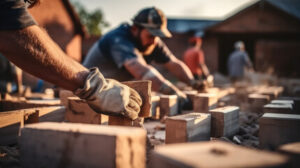Masonry Repair Charleston SC involves fixing brick structures when they begin showing signs of deterioration. It typically consists of filling in cracks and replacing damaged or rotting materials to preserve the structure’s structural integrity.

If you notice any signs of damage to your masonry, such as displaced bricks or a lack of expansion joints, it’s essential to contact professionals specializing in this type of work immediately.
It’s no secret that masonry structures can crack over time. But understanding why these movements occur can help you to determine the appropriate response and repair. Cracking in masonry generally falls into one of three categories: movements, overloading and material failure.
Cracking caused by imposed movements in a building structure are the most common and most serious type of cracking. Movements can be due to ground heave, differential settlement between foundation and masonry, or deflection of concrete supporting elements. The ability of a building to accommodate these movements depends on the materials used and how they are incorporated in a structural design.
Depending on the nature and severity of the imposed movement, a structural engineer may need to be involved in assessing the potential impact of the cracking, and how best to repair it. Cracks should be repaired with techniques that improve the tensile and flexural strength of the wall to allow it to accommodate minor and cyclic movements.
Hairline thermal cracks, sometimes referred to as ‘snaking’, usually appear in a brick or stone wall around windows and doors. These are a result of differential movement between the columns and masonry as they respond to temperature change. This can be avoided by ensuring good bonding between the columns and masonry.
Differential cracking can occur in a masonry structure when two different substances react to environmental changes differently, such as the difference between clay bricks and steel reinforcing bars. This type of cracking is often caused by insufficient bonding between the different material, and can be prevented by introducing joint separators between the material.
To repair these types of cracks, fill the crack with a mix that is slightly stiffer than normal (e.g. a lime-based mortar). Working from the back of the slot, fill to about two thirds full, masking over any existing finish with duct tape. Then push the crack stitching bars into the grout ensuring they are fully encapsulated. Once set, remove the duct tape and mask and finish the grout to match existing joints and brick or block textures.
Loose Bricks
A single loose brick may not seem like a big deal, but it can have serious consequences for your walkways, steps, and walls. Masonry repair specialists know how to fix these problems quickly and effectively. This can help prevent further damage to your structure and keep it safe for you and your loved ones.
Loose bricks can occur for a variety of reasons. The mortar could be failing, and the bricks themselves might be absorbing too much water. This can cause them to become soft and brittle over time, leading to structural issues. In some cases, the bricks can even fall off, posing safety hazards.
To correct this problem, it is important to remove the loose brick and clean off the old mortar. This can be done by using a mason’s chisel and hammer or a wire brush. Next, apply a new layer of mortar with a brick trowel. It is important to match the texture and aged color of the brick as closely as possible to ensure that the repair looks natural. Lastly, it is recommended that you use a brick stain to protect the mortar from the elements.
Brick structures should be inspected regularly to catch any potential problems. This can be done through inspection techniques and by seeking professional assistance. By catching problems early, you can prevent further damage and save money on future repairs.
A few simple maintenance steps can keep your brick structure in good condition for years to come. Inspecting structures for discoloration, rust marks and leaks can help to spot issues before they become more severe. Installing proper drainage systems and waterproofing measures can also reduce the risk of moisture damage. Regular cleaning with a suitable masonry cleaner can prevent mold and rust stains from forming.
Indentations
When a building or structure has indentations that indicate the presence of water seepage, masonry repair is often needed to address these issues. This typically involves removing and replacing bricks or stones that have lost their structural integrity and can cause further damage to the surrounding material.
Masonry repair can be a complex and involved process that involves restoring the original materials used in a building’s construction. When done correctly by professionals who specialize in historic preservation, this can help to preserve the unique character and history of a building for future generations.
Moisture is the enemy of masonry, and over time it can cause the structure to deteriorate or crack. This can be caused by heavy rainfall or flooding, or even simply high humidity levels. If left unattended, these problems can become much more serious and may compromise the safety of those using the building. In order to avoid costly repairs and maintenance, it’s important to address these issues promptly.
The type of masonry repair required will vary depending on the building and its condition. Some surfaces may need a simple coating of protective sealant to prevent further weathering, while others may require extensive patchwork and restoration from an experienced mason.
In addition to repairing structural concerns, masonry repair can also include indenting or replacing damaged or decayed stonework. This requires a thorough inspection of the existing material to determine the best course of action. Indent repair should always be carried out with a view to minimising the amount of new material being introduced to the structure, and should also consider how the replacement stone will interact with adjacent masonry. This will ensure that the new stone is both physically and visually compatible with the existing material, helping to preserve the remaining structure for as long as possible.
Careful attention should also be paid to all masonry details which are intended to shed rainwater, such as drips on cornices and other projecting mouldings and falls on copings and cornices. If these are not adequately protected and maintained, they can lead to stone decay as they form damp-traps.
Cracked Plaster
Cracked plaster is usually a cosmetic problem, but it can also signal an issue with the structure of your home. The good news is that it is easy to repair this type of crack.
Most plaster cracks are caused by moisture, temperature changes, and other factors that put stress on the material of your walls. This stress can cause the materials to expand and contract more than they are designed to. As the materials move, they can become entangled and eventually crack.
One way to prevent this is by sanding the wall before applying any finishes, including paint or plaster. The sanding process will remove any loose particles and smooth out the surface, helping the cracks to close. If you do notice a crack, use a utility knife or putty knife to gently widen the crack and undercut it. This will allow the filler to grip the surface and make a strong bond.
When you are ready to begin repairing the crack, apply some joint compound to the tape that covers the crack. If the compound has safety warnings on it, follow them carefully. Next, sand the compound and the surrounding wall with a fine grit of sandpaper (120-220 grit). The goal is to make the surface appear smooth to the naked eye.
Once you have sanded the surface, wipe away any remaining dust and dirt from the crack. Dampen the crack, then cover it with another layer of joint compound. Make sure that you do not overlap the previous layer by more than a few inches.
After the final layer of compound is applied, let it dry overnight. Then, sand the surface again with a finer grit of sandpaper. This will remove any sharp edges and give the surface a smooth finish.
It is important to address any plaster cracks as soon as they are noticed. These cracks can cause structural issues and affect the value of your home. In addition, minor cracks that aren’t repaired can spread and become more serious over time. It is possible to avoid more serious cracks by being careful around your walls with heavy objects, not hammering into them, and rearranging furniture often. If you see any major cracks, it’s best to contact a professional for masonry repairs.

